I’m hoping for a better matched cam in a year. Then this intake will make more sense.A Victor with a 232*@050….. naaaaaaa
You are using an out of date browser. It may not display this or other websites correctly.
You should upgrade or use an alternative browser.
You should upgrade or use an alternative browser.
340 stroker 422
- Thread starter Miszny
- Start date
-
Well, “Thank you on behalf of myself I hope we pass the auditions!”You guys are the best so I posted this here for opinions.
(The Beatles)
Ok, cool! That oughtta be a nasty Challenger.Ok I will say it, this is going into 73 Challenger with RMS suspension kit.
You guys are the best so I posted this here for opinions.
justinp61
Well-Known Member
- Joined
- May 15, 2009
- Messages
- 3,146
- Reaction score
- 4,149
I for one wouldn't hesitate to put the Victor on this 422. With the 4" crank and the small cam the bottom end will be fine. I've said many times, if you build a 4" stroke small block and it's soft on the bottom end you made an error in selecting the parts.
mikedevore
Well-Known Member
Send it, you can get away with that compression by using aluminum heads. I built a zero deck 360, .027 Cometic head gskt & eddy heads, ran it at 32 degrees total timing. No problem running on pump 91 octane premium. Had it in a Dart Sport, ran 11.30's.Hi
I recently started building a 340 stroker.
The block was rough so we went with 4.100 bore. Walls are still thick so it should be fine.
I got:
- Molnar 4.000” crank
- Scat 6.123” rods
- Wiseco k0144a100 flat top pistons
- Very nicely ported RPM heads
- Performer rpm intake
- Felpro 1008 head gaskets .039” thick
- Hydraulic roller cam 232/[email protected] 108lsa .565” lift
Cam card calls for 104 icl, after retard of 2 degrees it came up at 104.5 degrees.
It was all nice till I realized my compression status. It’s going to be 11.83:1 static and 10.12:1 dynamic…
Is there any chance for this to work on premium pump gas?
View attachment 1716020746
View attachment 1716020747
View attachment 1716020748
Same deal here bro! Except around my old grounds it’s ether 89 or 93 and 93 is what it got.Send it, you can get away with that compression by using aluminum heads. I built a zero deck 360, .027 Cometic head gskt & eddy heads, ran it at 32 degrees total timing. No problem running on pump 91 octane premium. Had it in a Dart Sport, ran 11.30's.
Rat Bastid
Dunamis Metron
Send it, you can get away with that compression by using aluminum heads. I built a zero deck 360, .027 Cometic head gskt & eddy heads, ran it at 32 degrees total timing. No problem running on pump 91 octane premium. Had it in a Dart Sport, ran 11.30's.
I‘ve said this before but since it keeps getting repeated I’ll repeat this.
Aluminum heads will NOT take any more compression than iron heads. That’s another myth that needs to die a quick death.
Unless of course you want to pull a 3 mile long 6% grade in high gear. If you do that you should be playing golf and not building or driving performance cars.
Last of the Fast
Active Member
I have a 340 Duster with the stock cam and heads (10.5:1) that pinged all the time. I won't tell you how I modfied that, but I outran a 1969 hemi Road runner 6 times out of 7 ( I missed a 2-3 shift once) and his car ran 12.17 at OCIR. The car was owned and driven by Bill Phillips who was workig for Motor Trend Magazine at the time (around 1971 I think).Send it, you can get away with that compression by using aluminum heads. I built a zero deck 360, .027 Cometic head gskt & eddy heads, ran it at 32 degrees total timing. No problem running on pump 91 octane premium. Had it in a Dart Sport, ran 11.30's.
I also built a Chevy 350 early LT1 that is a cc'd 12.5:1 compression ratio with a negative deck clearance (pistons stick out of the block at TDC by .020), running a permatorque head gasket that is .034 compressed. The cam is a Sig Erson HiFlow I Hydraulic installed straight up. Carb is a Holley 780 Vacuum Secondary (retrofitting a FiTech 600 hp unit). Here is how I keep my quench (twisted wedge aluminum heads) and still run on pump gas: I run 18 degrees initial ignition timing and the rest is ALL controlled by VACUUM! No mechanical advance whatsoever. It runs on 91 octane California gas and the acceleration in my 1971 Vega will make your eyes bleed. Most people think that you need to run 34 degrees total, but that is not true if you have a fast burn chamber. The main/ONLY consideration is where the piston is during the burn cycle. I used to have a small journal 327 in this car since 1976 with the same cam and stock iron heads and drove it back and forth to work (20 miles) for over 300,000 miles. It still passed smog when I took it out. The car is a little heavier now (3200 pounds) because I installed a subframe that goes from the engine mounts all the way to the rear end mounts (narrowed 12 bolt with posi). I used to have a 400 turbo hydro with an overdrive, but broke one of the gears in it. I now have a 700R4 with a 2200 rpm stall speed convertor. This setup works. My mentor for the negative deck height was Doug Roe (chief head design research engineer for Chevrolet for 17 years).
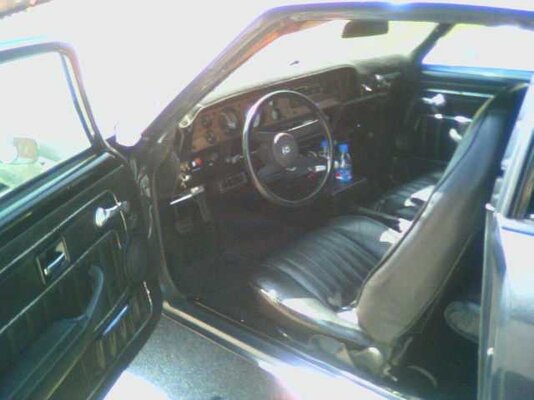
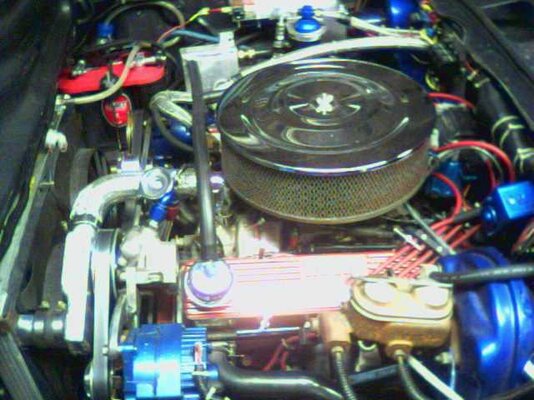
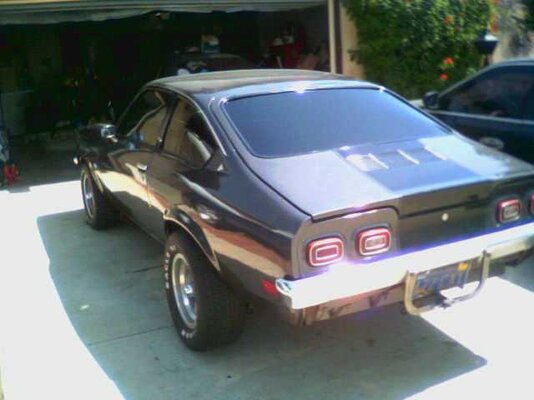



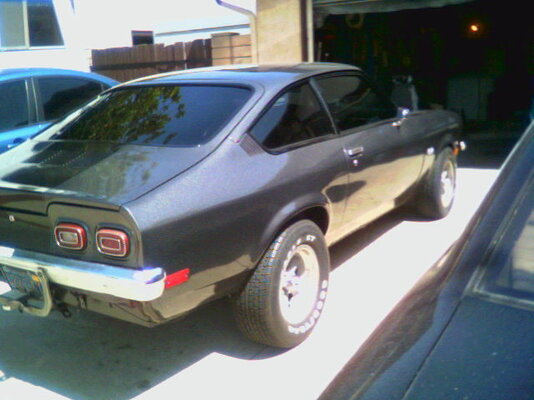
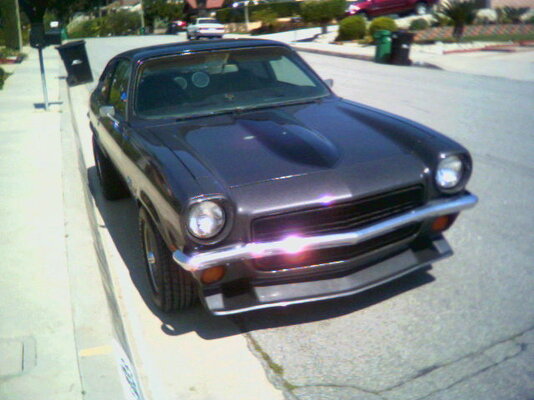
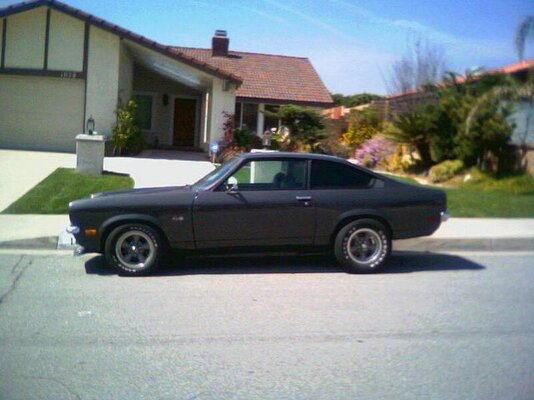
So …. You are realllly…. A Chevy guy…… 
And here’s the kicker, you ride pinged all the time but you won’t share how you cured it. LMAO! Some brother you are.
Definitely a Chevy guy.

And here’s the kicker, you ride pinged all the time but you won’t share how you cured it. LMAO! Some brother you are.
Definitely a Chevy guy.
Last of the Fast
Active Member
The main thing I did was remove the mechanical advance and just rely on initial setting and vacuum. The rest of the stuff was due to having the stock cast iron heads. The stock iron heads don't have much in the way of quench, so I had to get pretty creative. The 340 was stock except for Hooker Headers, Edlebrock intake manifold, Holley 750 Double pumper, and a 4" tall air filter element but without the stock enclosure. Now, go get 'em HotRod!
Last of the Fast
Active Member
Funny and clean
Love it!
Using alum for heads allows for a higher comp ratio. That is because of the superior heat dissipation of alum over cast iron. More heat is lost to the alum, so CR needs to be increased to compensate.
Nice lookin Vega. I love the early ones. But, just so you know, pistons past the block deck at TDC is positive deck clearance, not negative.I have a 340 Duster with the stock cam and heads (10.5:1) that pinged all the time. I won't tell you how I modfied that, but I outran a 1969 hemi Road runner 6 times out of 7 ( I missed a 2-3 shift once) and his car ran 12.17 at OCIR. The car was owned and driven by Bill Phillips who was workig for Motor Trend Magazine at the time (around 1971 I think).
I also built a Chevy 350 early LT1 that is a cc'd 12.5:1 compression ratio with a negative deck clearance (pistons stick out of the block at TDC by .020), running a permatorque head gasket that is .034 compressed. The cam is a Sig Erson HiFlow I Hydraulic installed straight up. Carb is a Holley 780 Vacuum Secondary (retrofitting a FiTech 600 hp unit). Here is how I keep my quench (twisted wedge aluminum heads) and still run on pump gas: I run 18 degrees initial ignition timing and the rest is ALL controlled by VACUUM! No mechanical advance whatsoever. It runs on 91 octane California gas and the acceleration in my 1971 Vega will make your eyes bleed. Most people think that you need to run 34 degrees total, but that is not true if you have a fast burn chamber. The main/ONLY consideration is where the piston is during the burn cycle. I used to have a small journal 327 in this car since 1976 with the same cam and stock iron heads and drove it back and forth to work (20 miles) for over 300,000 miles. It still passed smog when I took it out. The car is a little heavier now (3200 pounds) because I installed a subframe that goes from the engine mounts all the way to the rear end mounts (narrowed 12 bolt with posi). I used to have a 400 turbo hydro with an overdrive, but broke one of the gears in it. I now have a 700R4 with a 2200 rpm stall speed convertor. This setup works. My mentor for the negative deck height was Doug Roe (chief head design research engineer for Chevrolet for 17 years).
View attachment 1716023402
View attachment 1716023403
View attachment 1716023404
View attachment 1716023403
View attachment 1716023402
View attachment 1716023404
View attachment 1716023402
View attachment 1716023403
View attachment 1716023404
View attachment 1716023410
View attachment 1716023411
View attachment 1716023412
Rat Bastid
Dunamis Metron
Using alum for heads allows for a higher comp ratio. That is because of the superior heat dissipation of alum over cast iron. More heat is lost to the alum, so CR needs to be increased to compensate.
LOL. That’s wrong. It’s been proven wrong.
Thats a strange fact that never goes away?
My high comp 440 with iron heads would run on unleaded no probs (12 to 1).
My mates high comp 440 with Edelbocks would rattle like a bag of nails on unleaded (11 to 1).
Maybe the old wives tale was reversed somewhere?
My high comp 440 with iron heads would run on unleaded no probs (12 to 1).
My mates high comp 440 with Edelbocks would rattle like a bag of nails on unleaded (11 to 1).
Maybe the old wives tale was reversed somewhere?
So …. You are realllly…. A Chevy guy……
And here’s the kicker, you ride pinged all the time but you won’t share how you cured it. LMAO! Some brother you are.
Definitely a Chevy guy.
I didn’t have to look but I did anyway. I knew he was from California and got lost. Lmao.
Last of the Fast
Active Member
A zero deck is when the pistons are level with the top of the block at TDC. A negative deck CLEARANCE is when the pistons stick out of the block. A positive CLEARANCE is when you have MORE clearance, such as when the pistons are down in the hole at TDC. The key word here is CLEARANCE. If you are still confused, ask yourself "what do the pistons have to clear at top dead center"? The answer is THE HEAD. I'm pretty sure that Doug Roe had it right. He designed the aftermarket head for the Vega 4 cylinder. I bought one and sent the block out to be machined for a negative deck clearance (.020 stick out at TDC) and with the engine together I actually measured the CLEARANCE with a feeler gauge through the spark plug holes. That was the only change that I made to that engine and the results were: 55 horsepower on a chassis dyno and the mileage went from 21.4 mpg stock to 43 mpg with the Doug Roe head (all freeway). I drove the car for 94,000 miles before I put a V-8 in it. I have over 50 years of experience with builds like this (the current 350), so please don't tell me that positive piston stick out @ TDC is positive CLEARANCE, because if you build one like that you are going to hear some noise when the pistons hit the head.
Rat Bastid
Dunamis Metron
A zero deck is when the pistons are level with the top of the block at TDC. A negative deck CLEARANCE is when the pistons stick out of the block. A positive CLEARANCE is when you have MORE clearance, such as when the pistons are down in the hole at TDC. The key word here is CLEARANCE. If you are still confused, ask yourself "what do the pistons have to clear at top dead center"? The answer is THE HEAD. I'm pretty sure that Doug Roe had it right. He designed the aftermarket head for the Vega 4 cylinder. I bought one and sent the block out to be machined for a negative deck clearance (.020 stick out at TDC) and with the engine together I actually measured the CLEARANCE with a feeler gauge through the spark plug holes. That was the only change that I made to that engine and the results were: 55 horsepower on a chassis dyno and the mileage went from 21.4 mpg stock to 43 mpg with the Doug Roe head (all freeway). I drove the car for 94,000 miles before I put a V-8 in it. I have over 50 years of experience with builds like this (the current 350), so please don't tell me that positive piston stick out @ TDC is positive CLEARANCE, because if you build one like that you are going to hear some noise when the pistons hit the head.
Your definitions are fine IF zero (.000) is actually zero.
To far too many zero can have a big plus or minus. They should be publically flogged and have all their tools confiscated.
Dartswinger70
Well-Known Member
Alot of bickering back and forth here I see...oh well Ill check in later on in the week... P.S. what is the 1968-71 340 is that positive deck clearance with the head .018 above the deck?
P.S. what is the 1968-71 340 is that positive deck clearance with the head .018 above the deck?
( I beleive it is...)
( I beleive it is...)
Rat Bastid
Dunamis Metron
Post #167. No, it is not wrong. You show proof that it is.
I do it all the time. I’ve been building iron headed high compression pump gas engines for YEARS. And aluminum heads don’t make a pinch of **** difference to detonation resistance or what compression ratio you can use. NONE.
Want MORE proof? Go watch the “Engine Masters” episode where they test it.
And then pay very close attention to the absolute ABUSE they did to the iron headed combination to make it fail.
Again, if you build and treat your equipment the way EM did that you have no business being anywhere near an ICE.
In fact, try fishing. Or golf. That’s more your speed.
Definitely, and like I said those eye brows look really big.Ok, so how are you figuring your compression ratio? If you don’t do a down fill you are relying on numbers then piston manufacture gave, and those aren’t always right.
You need to do a down fill and do the math and see exactly where you are.
-

















